The Google Knowledge Graph is an enormous database of information that enables Google to provide immediate, factual answers to your questions. If you’ve ever Googled a query and received a useful answer without having to make another click, you have the Google Knowledge Graph to thank.
Maybe you never considered how Google collects accurate info, or maybe you’re just curious as to what it can mean for your website’s SEO.
Here, we’ll discuss some industry best practices and tools that can give you a head start on working with Google Knowledge Graph.
What Is the Google Knowledge Graph? What Are the Benefits of the Google Knowledge Graph? How Does the Knowledge Graph Work? How Does It Influence SEO and Why Is It Important? How to Get on the Google Knowledge Graph Useful Semrush Tools Important Notes to Remember about the Google Knowledge GraphWhat Is the Google Knowledge Graph?
Simply put: the Google Knowledge Graph is filled with billions of facts on various people, places, and things. Such facts (often categorized into ‘entities’) cover everything from niche topics to public interest topics like medicine and science. Overall, there are more than 5 billion entities and over 500 billion facts on the Graph.
It might help to picture the Google Knowledge Graph like a mind map. Not only does it understand what each entity is, it can track how different entities connect to each other.
For this reason, the term ‘knowledge base’ might actually be more accurate than ‘database,’ as it indicates the processing power Graph gives to the Google search engine.
Based on your search query and the information stored in the Google Knowledge Graph, Google can put two and two together and amass the relevant facts for you to make your life easier.
For example, if you wanted to know something about us, you could ask Google “When was Semrush founded?” Google will be able not only to answer the question you asked, but also offer you information on who our founders are, where our headquarters are, and where you can find us on social media.
Google presents this information in the form of Knowledge Panels or Knowledge Cards. These are info boxes that appear like this:
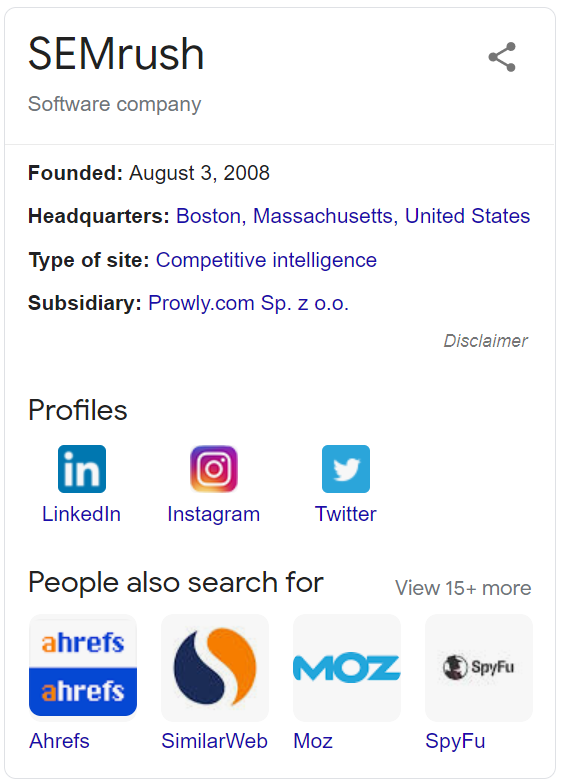
or this:
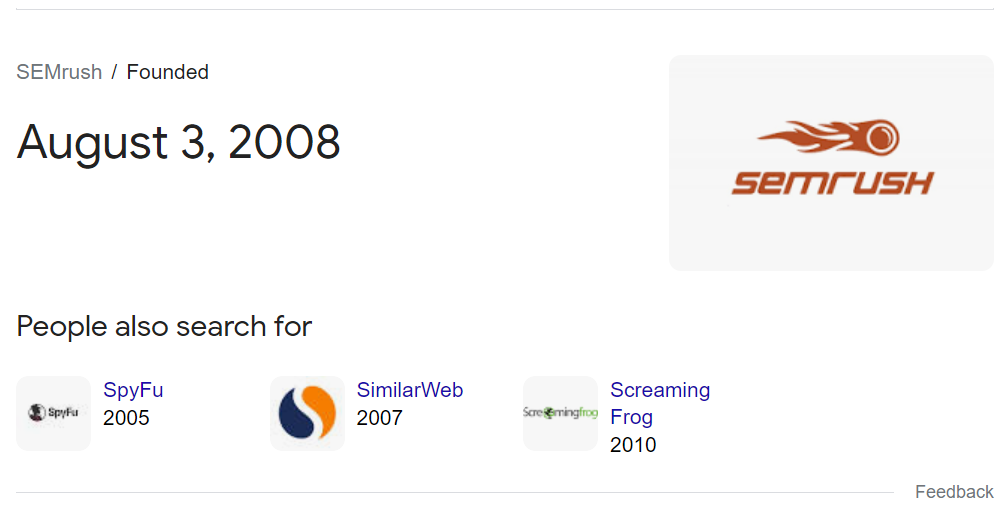
What Are the Benefits of the Google Knowledge Graph?
The Knowledge Graph works to give users speedy and clear answers to their questions, as well as answering further queries without any further clicking around.
Using the example of Tom Cruise, Google says that with just one query from the user, its knowledge graph enabled the search engine to answer “37% of next queries that people ask about him” via the Knowledge Panels.
This means no more clicking through website pages full of text to find a straight answer or typing endlessly into the Google search bar. Google’s done it all for you.
At first glance, the Google Knowledge Graph seems like a sort of magical fountain of knowledge rather than a feat of modern internet engineering. But of course, it takes quite a bit of work to maintain something like the Knowledge Graph.
How Does the Knowledge Graph Work?
You might be wondering where Google gets all this information from. Google fuels its knowledge graph through finding and licensing data.
This data is collected from a variety of different sources: both those that are publicly accessible and those that are privately licensed. However, the Google Knowledge Graph has been criticized in the past for answering queries without citing sources.
This means that people may assume they’re getting the most up-to-date information, when actually they’re just getting the information that’s most readily available on the Graph.
So, how can this be avoided? How does Google keep its Knowledge Graph up to date? And how can you help improve the Knowledge Graph? Well, anyone can give feedback on Knowledge Panels and suggest changes.
The information that’s shown in the Knowledge Panels is generated automatically and is mainly based on previous searches, but it can be updated manually too — as long as it’s in line with Google’s strict criteria.
If you’re the subject of a knowledge panel or the official representative of that subject and you can see that there’s incorrect information on one of the Google Knowledge Panels, you can claim the panel or suggest changes.
To go back to our Semrush query example, if we wanted to dispute the date we were founded, we would click the Feedback button:
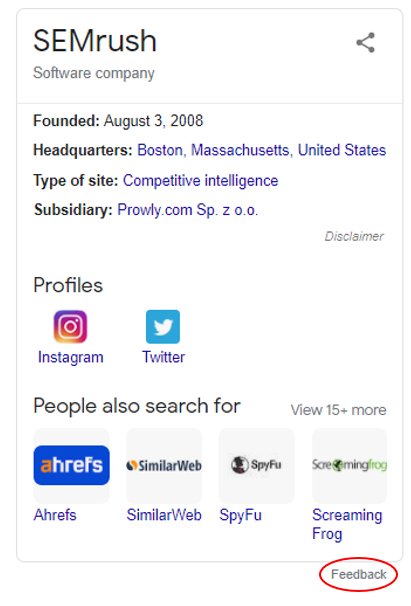
Choose what we wanted to give feedback on:
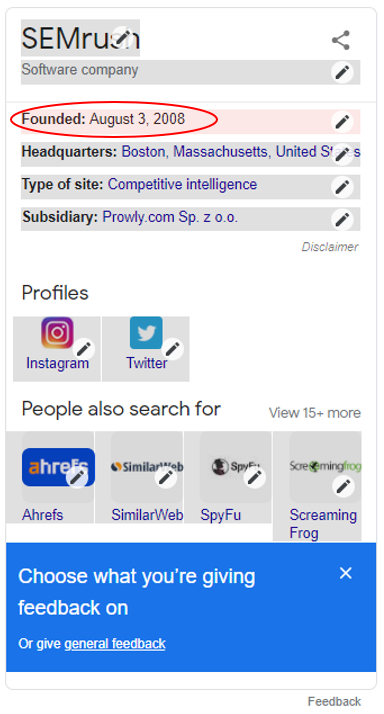
And fill in their handy form:
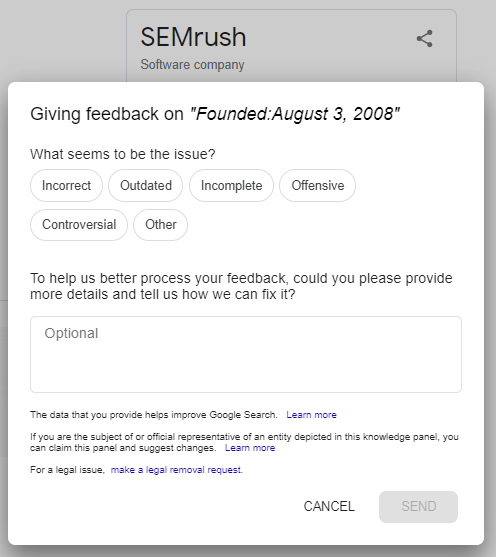
So, there are lots of ways in which Google keeps its Knowledge Graph up to date and accurate, including information freely volunteered from you.
How Does It Influence SEO and Why Is It Important?
Of course, it may have already occurred to you that there is one fundamental problem with the Google Knowledge Graph if you run a website.
Because Google offers answers to users directly on its results page, they often don’t have to click on any links to find information, which means that visits to your site due to branded search will go down, along with click through rates.
The graph below shows how click-through rates decreased between 2014 (two years after the Google Knowledge Graph’s introduction in 2012) and 2016. In both the EU/UK and in the US, the number of searches that didn’t result in a click increased by around 2% as people adjusted to the graph’s benefits. The organic click-through rate continued to decrease over time.
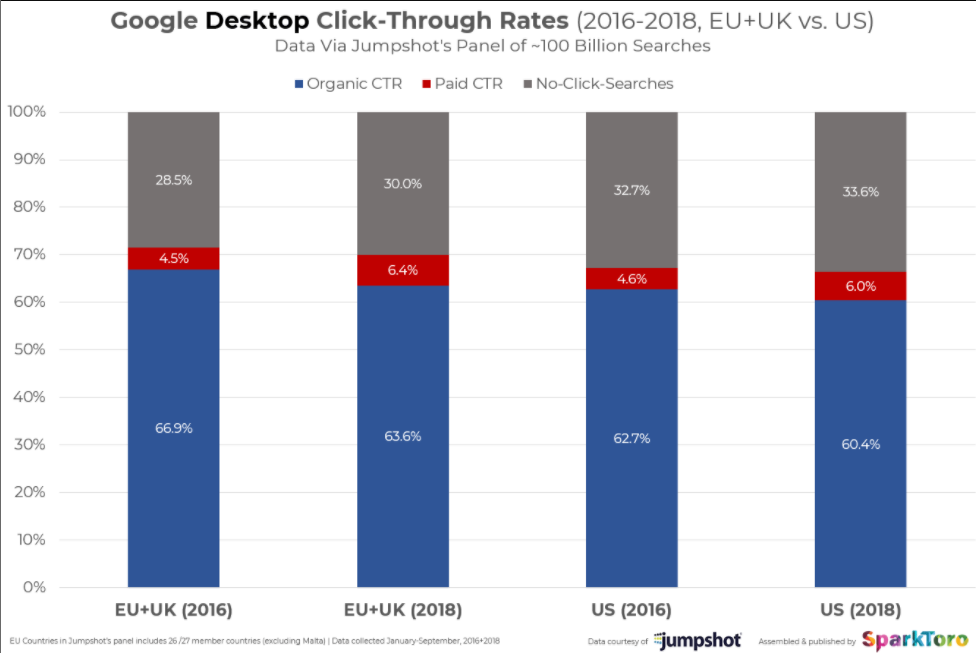
This obviously isn’t great news for those who need clicks to get sales. After all, if there’s no need to visit a website to find out when a company was founded, then there’s no further impulse on the part of the user to click any of the links on that company’s website homepage, and therefore no direct sales outcome.
An additional impact that the Google Knowledge Graph can have on SEO involves answering a query, Google will always look at the pre-existing knowledge in its graph before checking the open web, which shrinks traditional organic opportunities. The impact is clear on the graph above, where the organic click-through rate decreased by over 3% in both the EU/UK and the US.
However, there’s no need to panic. If you can get on the graph, all your worries may be over.
How To Get on the Google Knowledge Graph
One way to combat these SEO headaches is to add yourself onto the Knowledge Graph and get featured in the Knowledge Panels.
Once Google has direct access to your information, knows that you’re trustworthy and can see that you’re giving search engine users what they want, it is more likely to bump you up to the top of search engine results pages and present your information to users in the form of Knowledge Panels and rich snippets. As we discussed in a previous webinar, this is a great way to increase your web traffic.
Of course, this is easier said than done. Here are four easy steps that you can take:
1. Connect with Google and Wikipedia
Keeping connected is everything. Most of the information on the Google Knowledge Graph comes from Wikipedia and from Google itself, so getting your foot in the door with these big players will really give you a leg up with the graph.
Simple steps you can take to do this include:
registering with Google Search Console (which helps you measure your site’s search traffic and performance); if you’re a business owner, signing up for Google My Business. This will increase your visibility and authority on Google, as well as giving you a feature on Google Maps.In terms of conquering Wikipedia, you definitely need to ensure that you’ve got a Wikidata entry. We’ve discussed how to create a Wikidata page and why it matters for SEO in a previous blog post, but at its core this is important because Wikidata stores all Wikipedia’s structured data — which is used in the majority of Wikipedia articles.
Speaking of Wikipedia articles, you will almost certainly benefit from having one of those too.
Getting a Wikipedia article might sound odd, but Wikipedia articles’ links point to the sources they use and make accessing your website easy. Thus, having an article on the reputed page could lead to more clicks in the long run.
2. Use schema markup
Schema markup can sound confusing at first, but it’s not that complicated at its core. Schema markup is a way of tagging your content so that Google can understand it.
If Google understands, for example, that you’re talking about the foundation of a website rather than the foundation of a building, it can flag your content for the right people searching with the right intent.
Another benefit of schema markup is that it sets you well on your way to:
getting rich snippets, getting a Knowledge Panel, appearing for some non-branded queries.Rich snippets are special search results that include information not stored in the meta description. They can look like this:

Or like this:

For more info, check out our blog posts on improving your SEO by using schema markup and how structured data can get you into the Google Knowledge Graph.
Stay active and consistent
One great way to show Google that you’re reputable is by making sure that your page, content, and information is up to date.
You can do this by staying active on your social profiles, organizing your content for platforms such as Twitter, Facebook, and LinkedIn, and keeping up with your competitors. LinkedIn in particular is another big open-source pot for the Google Knowledge Graph.
Post as regularly as possible and develop your PR strategy. A good reputation amongst your peers and a loyal following will go a long way to helping Google see you as a trustworthy figure online.
Create great content
This final step may sound obvious, but that’s only because it’s essential. Google’s top priority is the user experience; it’s focused on giving people what they want efficiently and effectively. The Google Knowledge Graph is evidence of that.
Therefore, content that prioritizes the user experience by utilizing keywords, meta titles and other classic SEO techniques, will stand out, rank higher, and will more likely get you onto the Google Knowledge Graph.
For more info on getting on the Google Knowledge Graph, you can also take a look at our previous webinar on getting entities and their attributes onto the Google Knowledge Graph, or watch our ten-minute run down via the Weekly Wisdom video on the Google Knowledge Graph with Jason Barnard.
In the next section, we’ll explore some ways in which you can keep track of all this and how we can help you with it.
Useful Semrush Tools
If this all sounds a bit daunting, don’t worry; we’ve got a range of tools that can help you master Google’s Knowledge Graph, including:
The Position Tracking tool
The Position Tracking tool tracks your SEO efforts with ease, informs you of any shifts in your Google rankings, and allows you to create reports of your progress.
While working on improving your presence on the Knowledge Graph, you can keep an eye on the rankings of any domain, subdomain, subfolder, or URL for the keywords you track to ensure that you’re providing the best online content possible.
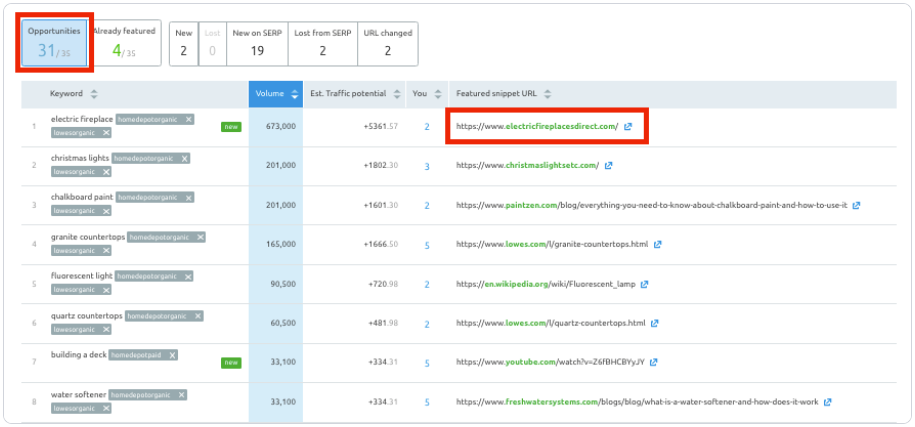
It even allows you to monitor your competition via the Competitors Discovery tab to see who’s also competing for the top spot.
As you can see below, the tool lets you filter by the top number of results and your chosen keyword, as well as by domain and tags.

2. The Organic Research tool
The Organic Research tool is great for discovering the keywords that are already working for your competitors, how much traffic each individual term drives organically, and which new keywords have helped your competition enter the Google top 20.
You can enter any competitor’s URL to see the keywords that they’re ranking for and how those keywords have ranked over time:
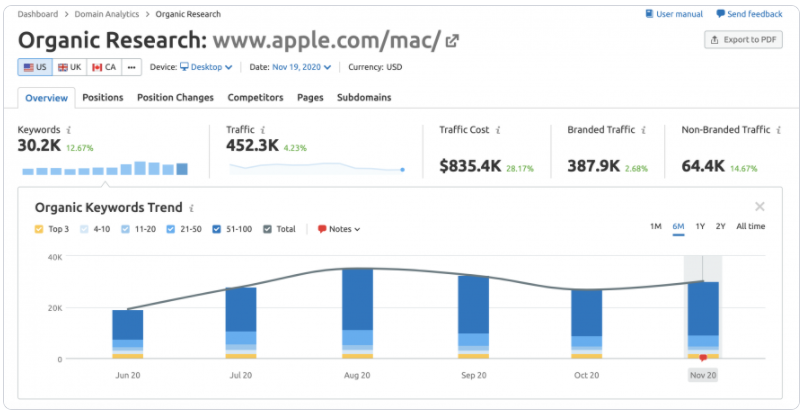
The Organic Research tool can help you understand what you are already doing right to improve your ranking, as well as your top pages, competitors, and keywords.
3. The Keyword Overview tool
Another tool available that can help you master the Google Knowledge Graph is the Keyword Overview tool.
This tool will run a complete analysis of any keyword you like and can help you decide whether it’s worth trying to rank for it. Our keyword database features over 20 billion keywords and 14 million suggestions per word on 120 country databases.
The tool provides you with information on the keyword’s search volume, difficulty, SERP insights and paid search data, as well as allowing you to track your keyword’s position in Position Tracking. This will help you improve the quality of your content to make it more user friendly and more appealing to Google.
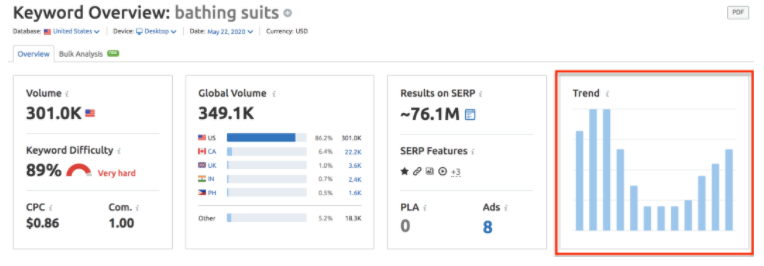
Important Notes To Remember about the Google Knowledge Graph
Powered by billions of entities and facts, the Google Knowledge Graph helps users navigate Google’s search engine every day and find speedy answers for their questions and queries.
The Google Knowledge Graph is a database like any other, and though it can pose a few problems for SEO, there are tips and tools to help you stay on top of it. Whether you’re looking for information on SERP Features with the Keyword Overview tool or tracking your keywords through the Position Tracking tool, our SEO toolkit can help make your experience as a site-owner on Google run smoothly.
Innovative SEO services
SEO is a patience game; no secret there. We`ll work with you to develop a Search strategy focused on producing increased traffic rankings in as early as 3-months.
A proven Allinclusive. SEO services for measuring, executing, and optimizing for Search Engine success. We say what we do and do what we say.
Our company as Semrush Agency Partner has designed a search engine optimization service that is both ethical and result-driven. We use the latest tools, strategies, and trends to help you move up in the search engines for the right keywords to get noticed by the right audience.
Today, you can schedule a Discovery call with us about your company needs.
Source:





